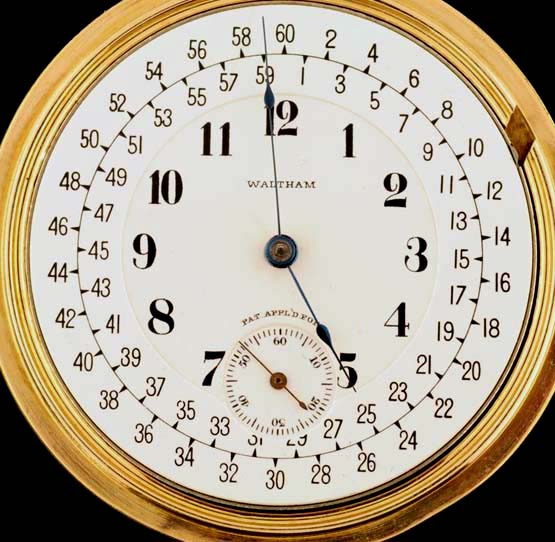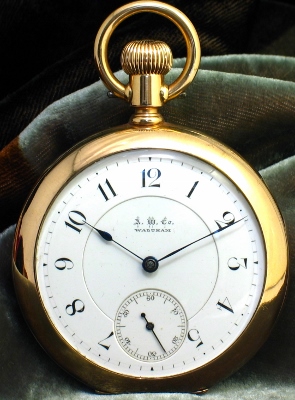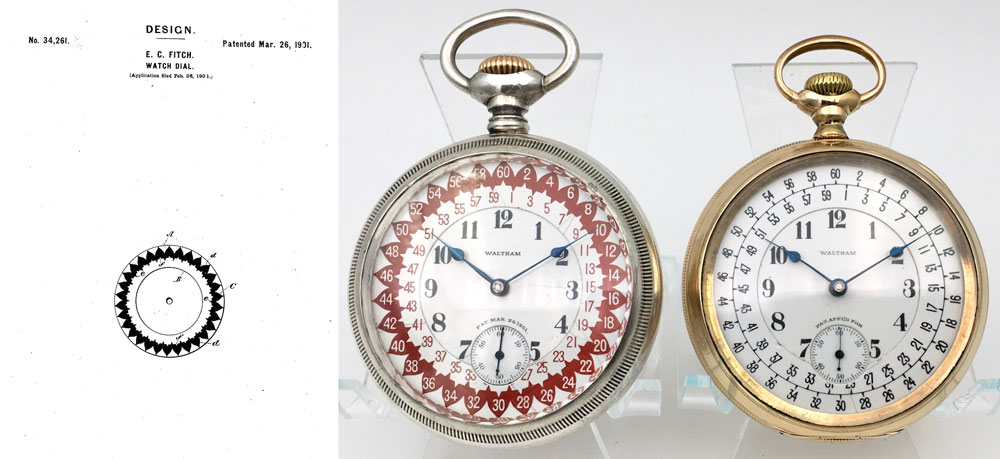
| WWT Shows | CLICK TO: Join and Support Internet Horology Club 185™ | IHC185™ Forums |

|
• Check Out Our... • • TWO Book Offer! • |
Welcome Aboard IHC185™  Internet Horology Club 185
Internet Horology Club 185  IHC185™ Discussion Site Main Page
IHC185™ Discussion Site Main Page  Horological Discussions, Questions and Answers
Horological Discussions, Questions and Answers  Pocket Watch Discussions
Pocket Watch Discussions  LOOK AT MY UNUSUAL DIAL...
LOOK AT MY UNUSUAL DIAL...
 Internet Horology Club 185
Internet Horology Club 185  IHC185™ Discussion Site Main Page
IHC185™ Discussion Site Main Page  Horological Discussions, Questions and Answers
Horological Discussions, Questions and Answers  Pocket Watch Discussions
Pocket Watch Discussions  LOOK AT MY UNUSUAL DIAL...
LOOK AT MY UNUSUAL DIAL...Go  | New Topic  | Find-Or-Search  | Notify  | Tools  | Reply to Post  |  |
| IHC President Life Member |
LOOK AT MY UNUSUAL DIAL... This topic can be to "show-off" or ask about, or perhaps research something we have not seen before or consider to be out-of-the-ordinary. Even after a quarter-century in the Pocket Watch Hobby every now and then I come across something unfamiliar or that I have not seen for some time. Your thoughts on the one below could be an interesting beginning...  | ||
|
| IHC Member 2134 |
No thoughts other than it's attractive! Mort Denison | |||
|
| IHC Life Member |
Nice dial, Lindell! What model watch is it on? Here's a dial I got several years ago, and have wondered if anyone else has seen one. About when would it have been made? | |||
|
| IHC Member 1610 |
Nice dial Lindell! I have seen several throughout the years. I have always liked them and always wanted one but I could not find one for the price I was willing to pay. Harry | |||
|
| IHC Life Member |
The dial below is a correct Waltham American Watch Grade Model 1872 dial, but very unusual in that it is double-sunk. It is on OF AWCo Model 1872 #2,605,082, which has a nonmagnetic balance and escapement, also unusual. It is in a 14k Waltham-signed case. AWCo Model 1872s are not abundant. Less than 2,000 were made. .jpg) | |||
|
| IHC Member 48 |
Wow! Nice looking dial Lin! | |||
|
I believe this dial to be attributed to Ezra Fitch of Waltham and is one of two variants, the other being a red and white version. Apparently not a successful dial, although I have seen a couple in the past, both on 18S model 1892 Crescent St. grades. Great dial. | ||||
|
| IHC President Life Member |
• Thanks Mort, I have long been intrigued by unusual dials, hence this topic. It takes the "marginal-minutes" design like that used by Montgomery to the next level. • Steven, That "Keystone-Elgin" marking throws me as I cannot recall any connection between the two names, but there it is! You gotta tell us the story behind that one! What size and type of movement? • Thanks Harry, the handful of these I have seen over the years, always on 1892-Model Walthams, always get my attention. I plan to sell one of the two we have in our collection as a "fund-raiser" for IHC in the near future. • Ethan, you always come up with something special, as are all the 1872-model Walthams. Thanks for sharing that one! • Keith, thanks, it is always great to hear from you! • William, you hit the nail on the head my friend... Yes that is one of the Ezra Fitch patents, this time on a dial. He also registered dust-proof crown and Swing-Out Case patents, later sold to Crescent Watch Case Company. A topic directly on Fitch, exploring his career and his patents would be very interesting and illuminating. Now, let's see some more unusual dials in this topic! Lindell | |||
|
| IHC Life Member |
Here's the movement and case on the Keystone-Elgin watch. 7 jewel from 1900. It's even in a Silveroid Keystone case, that looks to be original, no other screw marks. The dial could have been made for, or sold at, a trade show. I got about 10 years ago as a non-running parts watch, but after cleaning it runs quite well! Looks like I need to find a case screw. Steve  | |||
|
| IHC President Life Member |
Steven, Your very unusual "Keystone-Elgin" marked dial really got my imagination going. We know that some left-over Hunter movements were re-dialed to be sold as Open-Face and that was what I originally anticipated, but according to Elgin records your number 8126126 began as an Open-Faced movement just as you found it. http://elginwatches.org/cgi-bi...126126&action=search I think what you have to be an original combination. Not an uncommon movement with some 133,000 produced but that dial... My best guess is that Keystone bought up leftover movements from Elgin and installed them in Keystone cases. Then, if that is so they were marketed through the use of "Keystone-Elgin" dial markings. The time-frame of your "Class 94, Grade 211" 16-size movement being 1898-1903 was in the same era during which Keystone was getting into the watch business through their acquisition of the Howard Watch Company which produced only higher-grade movements. Perhaps selling 7-Jewel "Keystone-Elgins" would have been an attempt at having a full range of movements for offering along with what many collectors today call "Keystone-Howards" to retail jewelers. And... what could the 3 stars on that dial have symbolized? I have nothing to base that theory of mine upon other than my own speculation, but would be interested in hearing your thoughts and those of others. So... everyone, what do you think? Lindell | |||
|
| IHC Life Member |
Lindell, That all sounds possible to me. So many possible variants, of all watches, in the past. If only dials could talk.... Steve | |||
|
Steve - Around 1896, the Keystone Watch Case Company became the exclusive selling agent for Elgin movements in Europe. Keystone maintained a sales office in London and another in Hamburg, Germany. Elgin provided the movements, and Keystone cased, exported, and sold them abroad often using the “Keystone-Elgin” moniker. In 1904, this partnership was extended, and Keystone became the sole agent for the entirety of Elgin’s export market, with the notable exception of Canada. A similar deal was made with Waltham in 1909. These exclusive arrangements became part of the antitrust case against the Keystone Watch Case Company in 1911. Since your watch fits within this era, it likely is a product of this partnership. Great dial. | ||||
|
There are at least three design variants of the Ezra C. Fitch dial. The one Lindell posted above is the most common variant. There is also a red annular variant (shown below) and black annular variant (not pictured) that match the patent illustration. The inverted annular design is described by Fitch as resembling “a somewhat-truncated acorn or shield.” The staggered marginal arrangement is not specifically described in the patent documentation, but the more common design variant is marked “Pat. Appl’d For.” Despite the indication that Fitch attempted to patent the staggered marginal design, no patent was specifically issued.  | ||||
|
| IHC Life Member |
Nathan, Thanks for the information on the elgin watch dial. I had no heard of the Keystone-Elgin arrangement in Europe before. I'll keep it with the watch. I've seen a few of the Fitch dials and wondered about them, too. Steve | |||
|
| Powered by Social Strata |
| Your request is being processed... |
|
©2002-2025 Internet Horology Club 185™ - Lindell V. Riddle President - All Rights Reserved Worldwide

